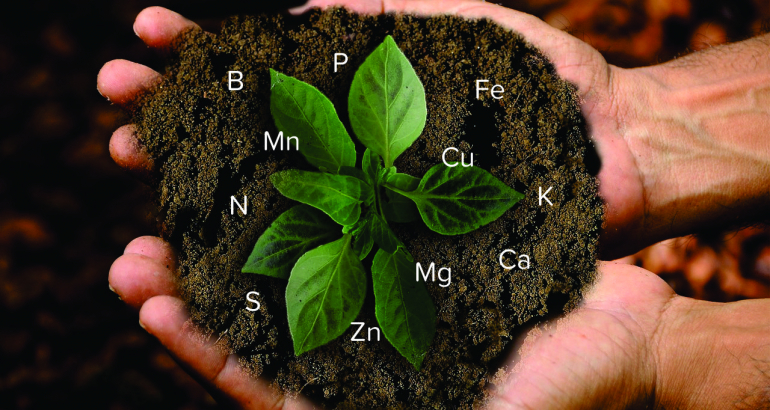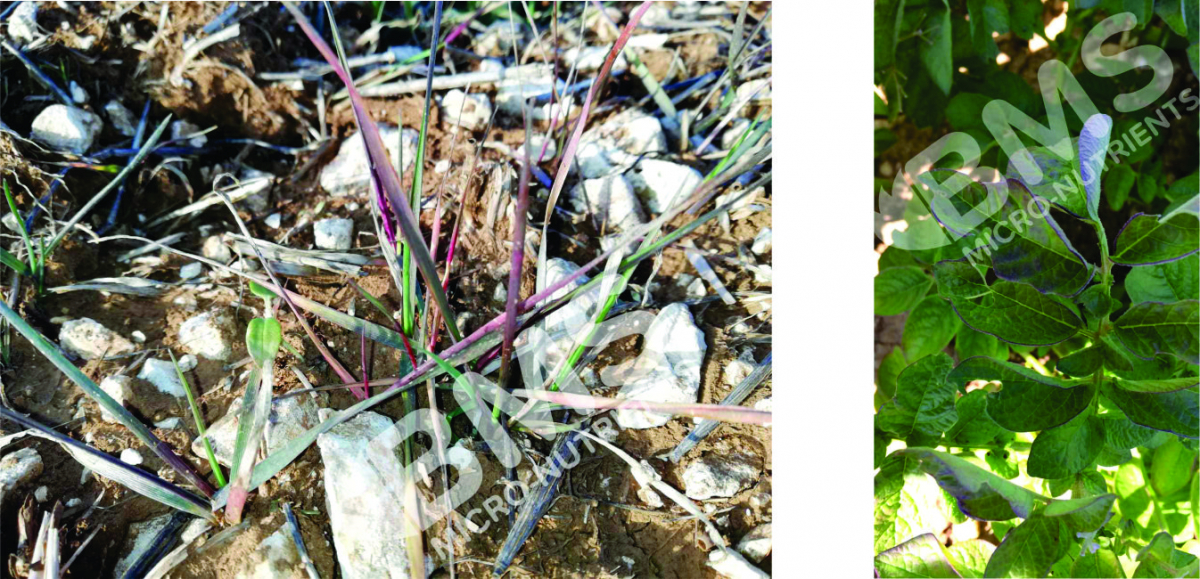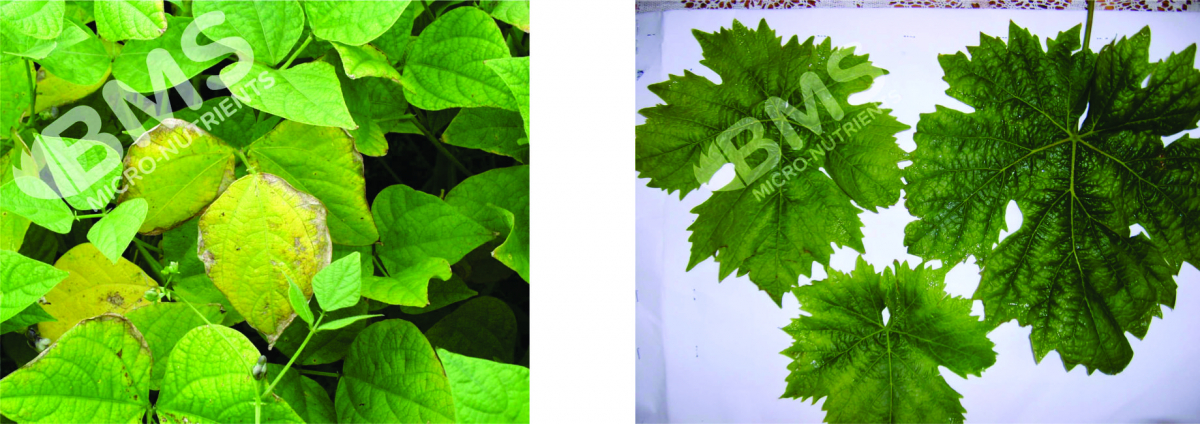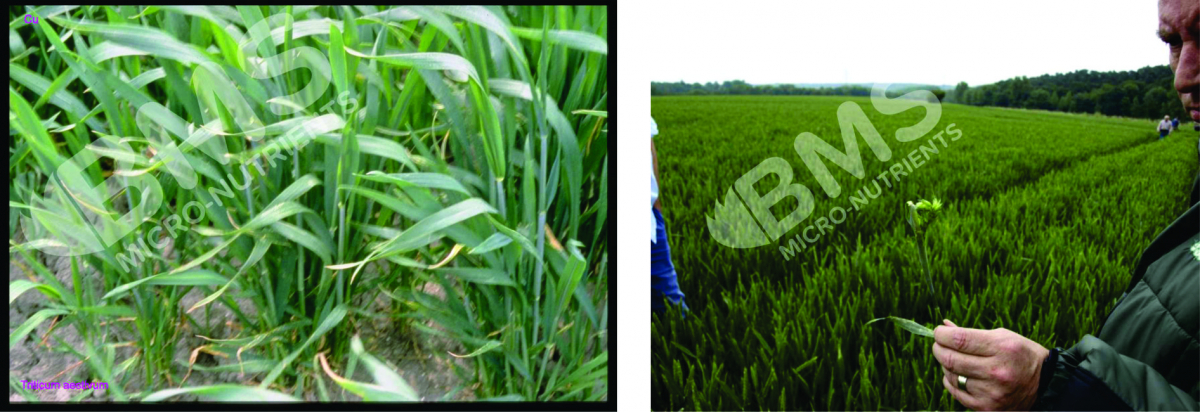You are here
How to recognize the element that is missing in the nutrition of your crop

In our previous blog post we explained what you should look out for, in general, to avoid deficiencies in your plant nutrition.
In this article you will get an overview of the symptoms associated with a deficiency of a specific nutritional element. We will list them out for you here so that you will soon know how to rebalance your crop.
Recognize the typical symptoms of the essential nutrients below.
Nitrogen
- General yellowing, of the whole leaf including the veins. First the oldest leaves become yellow, but nitrogen deficiency quickly leads to a general yellowing.
- Initially, no necrosis or no deformation of leaves or stems.
- Especially occurs on light sandy soils, especially after excessive rain that causes strong leaching and in case of limited nitrogen fertilization. Soils with a low organic material content are also more sensitive to this deficiency.
- General growth retardation
- Special patterns sometimes appear on the field. These are the result of uneven distribution of nitrogen fertilization: overlapping rows have fewer deficiencies because they received a higher dosage of nitrogen fertilization.
- In the case of corn, there is a very specific symptom: formation of a yellow triangle at the top of the leaf. The leaves remain green at the base.

Phosphorus
- The most characteristic symptom of phosphorus deficiency is undoubtedly a red / purple discoloration of the older leaves, usually also the veins.
- Necrosis usually does not occur, except for severe deficiencies.
- Appears mainly in the spring with cold weather. Due to the cold weather, the activity of the roots is still limited.
- Phosphorus deficiency is also often observed in younger plants with a smaller root system.
- General growth retardation
- Bad root development
- Smaller plants
- Is more common on heavy clay soils, especially if the pH is high.

Sulfur
- General yellowing of both of the leaf tissue and the veins, usually first of the younger parts of the plant and later on of the entire plant.
- In the first instance, no necrosis or deformation of leaves or stems can be seen
- Especially on light sandy soils. Sulfur is quickly washed out by excessive precipitation
- General growth retardation
- Do not confuse this deficiency with a nitrogen deficiency; the symptoms are often the same. Nitrogen deficiency is more frequent. In any case, check whether your fertilizers contain any form of sulfur or not.
- A deficiency of sulfur is less frequent, but occurs lately more and more often because there is less supply of sulfur through the precipitation. The 'cleaner' fuels provoke less sulfur emissions. As a result, there is also less sulfur supply through precipitation.
Potassium
- The first and most recognizable symptom of a potassium deficiency is leaf edge necrosis on the oldest leaves.
- This can be accompanied by yellowing. This yellowing will also start at the edges of the oldest leaves and then evolve to the center of the leaf, followed by the typical leaf edge necrosis.
- Sometimes the leaf edge will be spared and the necrosis does not start on the edge but on the inner part of the leaf between the veins.
- A potassium deficiency affects fruit quality. Fruits color more difficultly and remain smaller.
- On vineyards and table grapes you can recognize the symptoms mentioned above but there are also some typical symptoms per variety:
- White varieties: a bronze / metallic appearance on the oldest leaves before necrosis appears.
- Red varieties: redness from the leaf edge, which spreads inwards, before the necrosis appears.
- Potassium deficiency is more common on crops carrying a large amount of fruits

Calcium
- The apical meristems are deformed and die without any noticeable symptoms on the oldest leaves.
- The upper part of the stem and flower bud can bend.
- Small and distorted leaves at the top
- Abnormally dark green leaves
- Premature flower and fruit fall
- If the plant starts to grow again after a period of deficiency, the leaves that were in development at the moment of deficiency often develop a typical deformation / desiccation or white edge. This symptom is known as tip burn which is common in lettuce and strawberry.
- Browning of the inside of a stem/head, around the growing point like with celery (black heart)
- Fruits can also show typical symptoms such as bitter pit on apple or blossom end rot on peppers and tomatoes.
- Generally you notice a bad shelf life of the fruits
- Deficiencies often coincide with weather conditions that interrupt and impede calcium absorption. Dark, cold and humid weather conditions reduce the plant's evapotranspiration and thereby reduces calcium absorption.

Magnesium
- Yellowing of the leaf tissue. The veins remain green.
- With the dicotyledonous, a band around the main veins also remains green. This is very typical for a magnesium deficiency. The pattern of the green veins is not always very fine. Sometimes the yellowing evolves from the edge towards the middle of the leaf, and in other situations the edge of the leaf also remains green, with only yellowing of the leaf tissue on the inner part of the leaf.
This yellowing first occurs at the oldest leaves.
- In the case of monocotyledonous (cereals), there is also a yellowing between the veins. A line pattern then arises. As these leaves are finer, there is no green edge around the veins.
- In all plants, this yellowing evolves relatively quickly to a necrosis. It appears first at the same places where the first yellowing took place.
- For cereals, the yellowing also evolves quickly to a necrosis between the veins which remain green. This necrosis also develops first from the edge towards the center of the leaf. (not to be confused with manganese deficiency on cereals: here the necrosis develops much less quickly)
- Premature leaf fall of the affected leaves
- Sometimes the discoloration may be brownish rather than yellow
- Occurs mainly on light sandy soils, especially after excessive rain because then the Gibbs-Donnan effect promotes the uptake of potassium from the soil. As a result, the plant absorbs less magnesium.

Boron
- A deficiency of boron affects the apical meristems (growth point). Sometimes it dies completely and the side shoots begin to grow, creating a broom effect.
- The affected meristems have shorter internodes whichare usually much thicker, with small and distorted leaves at the top.
- General dwarfism due to the shorter internodes
- Cracks and tears can often be seen on the stems
- Poor flower formation, flowers are smaller and deformed.
- Poor fertility, resulting in fewer seeds in the fruits.
- Fruits are often deformed and may also have corked cracks or spots.
- Necrosis is possible on the older leaves.
- Internal discoloration (brown) and formation of cork in the fruits and stems, or the formation of hollow stems
- Sugar beet: the typical "heart rot": The growth point will rot and die completely. This creates a cavity in the middle at the top of the beet.

Molybdenum
- Molybdenum is responsible for the nitrogen processing in the plant. Therefore, many symptoms of a deficiency of molybdenum and nitrogen are similar.
The plant does not use and process the nitrogen without molybdenum. This is especially the case with pulses which require extra molybdenum in their nodules to fix the nitrogen from the air.
- Smaller plants with a pale green color. The discoloration can develop into yellowing, first on the edges and then between the main veins.
- In addition, there are also typical symptoms of a molybedenum deficiency in cruciferous and cucurbitaceae
- The leaf disc disappears almost completely and only the main vein of the leaf remains with small pieces of the leaf. This main vein is usually also curled. ("Whiptail symptom")
- The leaves remain smaller and sometimes take the shape of a spoon: curled edge and curved main venerin .

Copper
- The symptoms of copper deficiencies are best known for cereals, because they are very susceptible to this deficiency.
- White discoloration in the tips of the younger leaves. These turn up like a corkscrew. This can necrotize in a further stage.
- The youngest leaves have difficulties to unfold.
- The ears difficultly come out of the leaf sheath and the ears contain few seeds: empty ears
- In the case of corn, the youngest leaves lose turgidity, they wilt and remain attached to each other at the top to form a loop.
- The top of the branches turn brown and bend.
- The youngest leaves roll up and wilt. Necrosis of the youngest growth points and of the leaf edges of the youngest leaves.
Although the oldest leaves are unaffected, the younger leaves are sometimes dark blue-green or gray-green.

Iron
- The deficiency of iron or "iron chlorosis" is perhaps the best known deficiency
- The yellowing starts clearly with the youngest, most recently formed leaves, while the older leaves initially remain green.
- The yellowing is usually first between the veins. The veins stay green and leave a green pattern on the leaves while the leaf tissue is yellow.
- In case of stronger deficiencies, this distinction is not always clear and these youngest leaves are almost immediately completely yellow.
- The yellowing evolves fairly quickly from the youngest leaves to the middle and the older leaves.
- At a further stage, a necrosis can appear usually beginning on the leaf edge and then develops over the whole leaf. Leaves then fall off.
- In vines and fruit trees, we sometimes see branches that are more affected than others and that remain clearly greener.

Manganese
- A manganese deficiency sometimes resembles the iron deficiency: chlorosis between the veins leaving a clear green network on the leaves.
- The big difference with iron chlorosis is that the first symptoms do not occur specifically on the youngest leaves but sometimes on the most recent but fully developed leaves (middle leaves).
Later on this also evolves to the younger and the older leaves.
- This deficiency always leaves behind a pronounced network of green veins. Sometimes much clearer than with the iron deficiency. It really looks like a mosaic of yellowish or light green spots.
- The symptoms also develop less rapidly towards full yellowing and necrosis.
- Sometimes there is confusion with a magnesium deficiency. The clearest difference between these deficiencies:
- The veins remain much finer green (also the smaller veins) in case of a manganese deficiency.
- With a magnesium deficiency, a much wider band remains green around the veins and the finest veins also turn yellow.
- Specific patterns can also be observed on the field. How to explain this? Manganese is better available in reducing soil conditions such as
- , in the more compacted soil caused by the wheels of heavy weight machinery on our fields.
- Or in places where water accumulates.
In these places it is possible that the deficiency is less severe and the crop is therefore greener. Hence the specific patterns on the field.
- In potatoes, we see very typical symptoms of a manganese deficiency:
- Small black necrotic dots appear on the middle leaves.
- These leaves are generally slightly lighter green.

Zinc
- You can recognize a deficiency of zinc, among other things, by dwarfism, due to the shortened internodes.
- Small, finer and narrower leaves at the top of the branches or on the young shoots.
These smaller leaves are not really deformed, only finer: "little leaf symptom".
- Sometimes formation of clusters and rosettes of many small leaves that stay close together because of the shorter internodes: "rosetting".
These leaves are light green to yellow.
- In fruit trees and other shrubs we often see a typical leaf position: branches with many leaves at the top that are relatively close to each other, and below that, a part of the stem with no leaves at all, and again further down a normal leaf position on the same stem.
- In corn we see first and foremost dwarf growth (with leaves that remain close to each other. On both sides of the main vein, especially on the youngest leaves, develop 2 typical pale green to white broad bands (both over veins as well as over the leaf tissue), while the leaf edges remain greener.
- In citrus, symptoms of the smaller leaves and the shorter internodes also show symptoms of amorphous yellow spots, which leave the main veins green. The pattern is somewhat uneven and asymmetrical.
